Related Research Articles
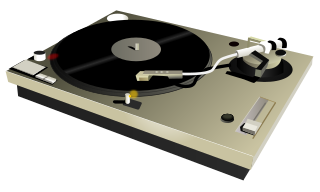
A phonograph, later called a gramophone, and since the 1940s a record player, or more recently a turntable, is a device for the mechanical and analogue reproduction of recorded sound. The sound vibration waveforms are recorded as corresponding physical deviations of a spiral groove engraved, etched, incised, or impressed into the surface of a rotating cylinder or disc, called a "record". To recreate the sound, the surface is similarly rotated while a playback stylus traces the groove and is therefore vibrated by it, faintly reproducing the recorded sound. In early acoustic phonographs, the stylus vibrated a diaphragm that produced sound waves coupled to the open air through a flaring horn, or directly to the listener's ears through stethoscope-type earphones.
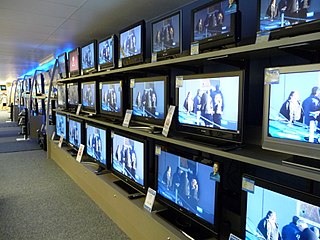
Television (TV) is a telecommunication medium for transmitting moving images and sound. Additionally, the term can refer to a physical television set, rather than the medium of transmission. Television is a mass medium for advertising, entertainment, news, and sports. The medium is capable of more than "radio broadcasting", which refers to an audio signal sent to radio receivers.

John Logie Baird was a Scottish inventor, electrical engineer, and innovator who demonstrated the world's first live working television system on 26 January 1926. He went on to invent the first publicly demonstrated colour television system and the first viable purely electronic colour television picture tube.

Phonograph cylinders are the earliest commercial medium for recording and reproducing sound. Commonly known simply as "records" in their heyday, a name which has been passed on to their disc-shaped successor, these hollow cylindrical objects have an audio recording engraved on the outside surface which can be reproduced when they are played on a mechanical cylinder phonograph. The first cylinders were wrapped with tin foil but the improved version made of wax was created a decade later, after which they were commercialized. In the 1910s, the competing disc record system triumphed in the marketplace to become the dominant commercial audio medium.

Color television or colour television is a television transmission technology that includes color information for the picture, so the video image can be displayed in color on the television set. It improves on the monochrome or black-and-white television technology, which displays the image in shades of gray (grayscale). Television broadcasting stations and networks in most parts of the world upgraded from black-and-white to color transmission between the 1960s and the 1980s. The invention of color television standards was an important part of the history and technology of television.

Videodisc is a general term for a laser- or stylus-readable random-access disc that contains both audio and analog video signals recorded in an analog form. Typically, it is a reference to any such media that predates the mainstream popularity of the DVD format. The first mainstream official Videodisc was the Television Electronic Disc (TED) Videodisc, and the newest is the 4K Ultra HD Blu-Ray Disc. As of September 2023, the active video disc formats are Blu-ray Disc, DVD, and in other regions because of the price difference from DVD, Video CD (VCD) and SVCD.
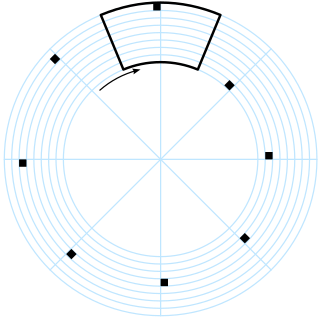
A Nipkow disk, also known as scanning disk, is a mechanical, rotating, geometrically operating image scanning device, patented by Paul Gottlieb Nipkow in Berlin. This scanning disk was a fundamental component in mechanical television, and thus the first televisions, through the 1920s and 1930s.
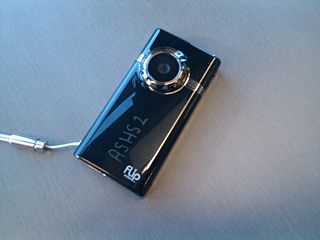
A video camera is an optical instrument that captures videos, as opposed to a movie camera, which records images on film. Video cameras were initially developed for the television industry but have since become widely used for a variety of other purposes.

Mechanical television or mechanical scan television is an obsolete television system that relies on a mechanical scanning device, such as a rotating disk with holes in it or a rotating mirror drum, to scan the scene and generate the video signal, and a similar mechanical device at the receiver to display the picture. This contrasts with vacuum tube electronic television technology, using electron beam scanning methods, for example in cathode-ray tube (CRT) televisions. Subsequently, modern solid-state liquid-crystal displays (LCD) and LED displays are now used to create and display television pictures.

Narrow-bandwidth television (NBTV) is a type of television designed to fit into a channel narrower than the standard bandwidth used for official television standards.

An image dissector, also called a dissector tube, is a video camera tube in which photocathode emissions create an "electron image" which is then swept up, down and across an anode to produce an electrical signal representing the visual image. It employs magnetic fields to keep the electron image in focus, and later models used electron multiplier to pick up the electrons. The term had also been used for other kinds of early video camera tubes. Dissectors were used only briefly for research in television systems before being replaced by different much more sensitive tubes based on the charge-storage phenomenon like the iconoscope during the 1930s. Despite the camera tubes based on the idea of image dissector technology falling quickly and completely out of use in the field of Television broadcasting, they continued to be used for imaging in early weather satellites and the Lunar lander, and for star attitude tracking in the Space Shuttle and the International Space Station.
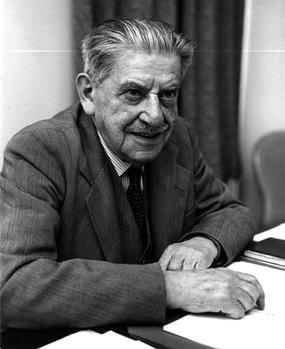
Sir Isaac Shoenberg was a British electronic engineer born in Belarus who was best known for his role in the history of television. He was the head of the EMI research team that developed the 405-line, the first fully electronic television system to be used in regular broadcasting when it was introduced with the BBC Television Service in 1936. It was later adopted by other TV organizations around the world.

The concept of television is the work of many individuals in the late 19th and early 20th centuries. The first practical transmissions of moving images over a radio system used mechanical rotating perforated disks to scan a scene into a time-varying signal that could be reconstructed at a receiver back into an approximation of the original image. Development of television was interrupted by the Second World War. After the end of the war, all-electronic methods of scanning and displaying images became standard. Several different standards for addition of color to transmitted images were developed with different regions using technically incompatible signal standards. Television broadcasting expanded rapidly after World War II, becoming an important mass medium for advertising, propaganda, and entertainment.
Analog high-definition television has referred to a variety of analog video broadcast television systems with various display resolutions throughout history.

Stooky Bill was the name given to the head of a ventriloquist's dummy that Scottish television pioneer John Logie Baird used in his 1924 experiments to transmit a televised image between rooms in his laboratory at 22 Frith Street, London.
A field-sequential color system (FSC) is a color television system in which the primary color information is transmitted in successive images and which relies on the human vision system to fuse the successive images into a color picture. One field-sequential system was developed by Peter Goldmark for CBS, which was its sole user in commercial broadcasting. It was first demonstrated to the press on September 4, 1940, and first shown to the general public on January 12, 1950. The Federal Communications Commission adopted it on October 11, 1950, as the standard for color television in the United States, but it was later withdrawn.
The following timeline tables list the discoveries and inventions in the history of electrical and electronic engineering.
Telechrome was the first all-electronic single-tube color television system. It was invented by well-known Scottish television engineer, John Logie Baird, who had previously made the first public television broadcast, as well as the first color broadcast using a pre-Telechrome system.
This is a timeline of the history of the BBC Television Service, from events preceding its launch in 1936 until its renaming as BBC1 in 1964 upon the launch of BBC2.
References
- 1 2 "Television Predicted". The Film Daily. Vol. XLI, no. 29. 4 August 1927. p. 1. Retrieved 13 August 2020.
- ↑ J L Baird, British Patent GB 320,909, 1927
- ↑ J L Baird, British Patent GB 324,909 October 1928
- ↑ Baird, John Logie (2004). Television and Me (Revised ed.). Edinburgh, Great Britain: Mercat Press Ltd. pp. 64–65. ISBN 9781841830636.
- ↑ Anon (8 October 1927). "Report: Demonstration at White Rock Pavilion". Hastings & St Leonard's Observer.
- ↑ Abramson, A (1955). Electronic Motion Pictures. University of California Press.
- ↑ Burns, R W (1986). British Television: The Formative Years. London, UK: IEE / Peter Peregrinus Ltd. ISBN 0863410790.
- ↑ McLean, Donald F (April 1985). "Computer-based Analysis and Restoration of Baird 30-line television recordings". Journal of the Royal Television Society. 22 (2): 87–94.
- ↑ McLean, Donald F (July 1989). "The Recovery of Phonovision". 3rd International Conference on Image Processing, IEE. 307: 300–304.
- ↑ McLean, Donald F (June 2019). "Seeing Across Oceans: John Logie Baird's Trans-Atlantic Television Demonstration". Proceedings of the IEEE. 107 (6): 1206–1218.
- ↑ "University of Glasgow: Collections". 2016. Retrieved 2 September 2023.
- ↑ Cracknell, A., Letter to D F McLean, 29 May 1993
- ↑ "The First Television Revue". Radio Times. 14 April 1933.
- ↑ McLean, Donald F (Nov 1998). "First Frames". Electronics and Wireless World. 104 (1751): 943–946.
- ↑ McLean, Donald F (December 1998). "Looking In...". Electronics and Wireless World. 104 (1752): 1031–1034.
- ↑ McLean, Donald F. "The Dawn of Television Remembered" , Enhanced CD documentary published in association with the BBC and the Royal Television Society, 2005
- ↑ McLean, Donald F (2000). Restoring Baird's Image. London, UK: IEE. ISBN 0852967950.